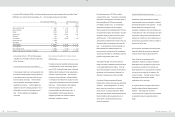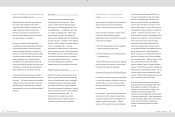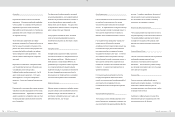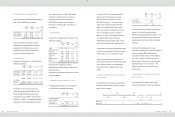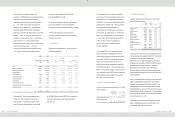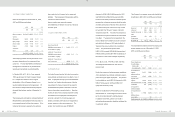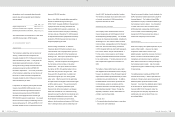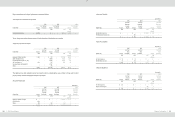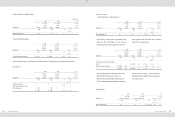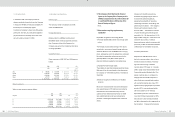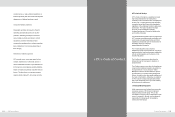HTC 2008 Annual Report Download - page 112
Download and view the complete annual report
Please find page 112 of the 2008 HTC annual report below. You can navigate through the pages in the report by either clicking on the pages listed below, or by using the keyword search tool below to find specific information within the annual report.
Financial Information
| 89
88 |
2008 Annual Report
Assumptions used in actuarially determining the
present value of the projected benefit obligation
were as follows:
2006
2007
2008
Weighted-average discount rate
2.75%
2.75%
2.75%
Assumed rate of increase in future compensation
4.25%
2%-4%
2%-4%
Expected long-term rate of return on plan assets
2.75%
2.75%
2.75%
The vested benefits as of December 31, 2006, 2007
and 2008 all amounted to NT$0 thousand.
21.STOCKHOLDERS’ EQUITY
Capital Stock
The Company’s outstanding common stock as of
January 1, 2006 amounted to NT$3,570,160
thousand, divided into 357,016 thousand common
shares at NT$10.00 par value. In May 2006, the
stockholders approved the transfer of retained
earnings amounting to NT$714,032 thousand and
employee bonuses amounting to NT$80,000
thousand to capital stock. As a result, the amount
of the Company’s outstanding common stock as of
December 31, 2006 increased to NT$4,364,192
thousand, divided into 436,419 thousand common
shares at NT$10.00 par value.
In April 2007, the Company retired 3,624 thousand
treasury shares (NT$36,240 thousand). In June
2007, the stockholders approved the transfer of
retained earnings amounting to NT$1,298,385
thousand and employee bonuses amounting to
NT$105,000 thousand to capital stock. As a result,
the amount of the Company’s outstanding common
stock as of December 31, 2007 was NT$5,731,337
thousand, divided into 573,134 thousand common
shares at NT$10.00 par value.
Also, in June 2008, the stockholders approved the
transfer of retained earnings amounting to
NT$1,719,401 thousand (US$52,421 thousand) and
employee bonuses amounting to NT$103,200
thousand (US$3,146 thousand) to capital stock. As
a result, the amount of the Company’s outstanding
common stock as of December 31, 2008 increased
to NT$7,553,938 thousand (US$230,303 thousand),
divided into 755,394 thousand common shares at
NT$10.00 (US$0.30) par value.
In their meeting on December 11, 2002, the
Company’s Board of Directors resolved to issue
7,000 thousand units of employee stock options in
accordance with Article 28.3 of the Securities and
Exchange Law. Each option represents the right to
buy one newly issued common share of the
Company. The exercise price is the closing price of
the Company’s common shares on the option
issuance date. The option holders can exercise
the right up to 35% of the granted option units no
earlier than two years from the grant date. After
three years from the grant date, the holders can
exercise their right at up to 70% of the granted
option units. After four years from the grant date,
the option holders are eligible to exercise their rights
on all the options owned. The exercise period is
five years. The Company had issued 3,000
thousand units of the stock options to employees
which were increased to 7,011 thousand units by
taking into account the effect of stock dividends and
the issuance of additional common stocks. After
the employees’ choosing to give up the stock
options in the first and second quarter of 2007, there
were no employee stock options outstanding as of
June 20, 2007, the date of stockholders' meeting.
The remaining employee stock options which were
not issued, amounting to 4,000 thousand units,
expired on December 25, 2003.
Global Depositary Receipts
The Company issued 14,400 thousand common
shares corresponding to 3,600 thousand units of
Global Depositary Receipts (GDRs). For this GDR
issuance, the Company’s stockholders, including Via
Technologies, Inc., also issued 12,878.4 thousand
common shares, corresponding to 3,219.6 thousand
GDR units. Thus, the entire offering consisted of
6,819.6 thousand GDR units. Each GDR represents
four common shares, with par value of NT$131.1.
For this common share issuance, net of related
expenses, NT$1,696,855 thousand was accounted
for as capital surplus. This share issuance for cash
was completed and registered on November 19,
2003.
The holders of these GDRs have the same rights
and obligations as the stockholders of the Company.
However, the distribution of the offering and sales of
GDRs and the shares represented thereby in certain
jurisdictions may be restricted by law. In addition,
the GDRs offered and the shares represented are
not transferable, except in accordance with the
restrictions described in the GDR offering circular
and related laws applied in Taiwan. Through the
depositary custodian in Taiwan, GDR holders are
entitled to exercise these rights:
a.To vote; and
b.To receive dividends and participate in new share
issuance for cash subscription.
Taking into account the effect of stock dividends, the
GDRs increased to 8,322 thousand units (33,287.9
thousand shares). The holders of these GDRs
requested the Company to redeem the GDRs to get
the Company’s common shares. As of December
31, 2008, there were 6,623.1 thousand units of
GDRs redeemed, representing 26,492 thousand
common shares, and the outstanding GDRs
represented 6,796 thousand common shares or
0.90% of the Company’s common shares.
Capital Surplus
Under the Company Law, capital surplus can only be
used to offset a deficit. However, the capital
surplus from share issued in excess of par
(additional paid-in capital from issuance of common
shares, conversion of bonds and treasury stock
transactions) and donations may be capitalized,
which however is limited to a certain percentage of
the Company’s paid-in capital. Also, the capital
surplus from long-term investments may not be used
for any purpose.
The additional paid-in capital was NT$4,410,871
thousand as of January 1, 2006. In April 2007, the
retirement of treasury stock caused a decrease of
additional paid-in capital amounted to 36,627
thousand. As a result, the additional paid-in capital
as of December 31, 2008 was NT$4,374,244
thousand (US$133,361 thousand). Under the
Company Law, the Company may transfer the
capital surplus to common stock if there is no
accumulated deficit.



